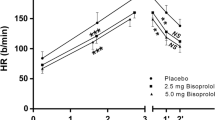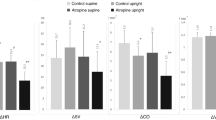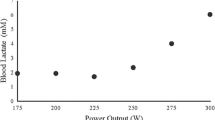Summary
The kinetics of oxygen uptake (VO2) were assessed in 17 normal subjects with Β-blockade and placebo. Β-blockade was achieved with either 50 mg oral metoprolol or 40 mg oral propranolol, each twice per day. Tests were conducted on the cycle ergometer at work rates approximating 80% of the work rate at ventilatory anaerobic threshold. Work rate was initiated as a square wave starting from prior rest. Data obtained 48 h, 1 week, and 4 weeks after starting drug or placebo were pooled to increase the number of points for regression analysis of kinetic parameters. While there were no differences in the plateau values for \(\dot V\)O2 with and without Β-blockade, the rate of adaptation to steady state was significantly slower with Β-blockade than with placebo (p<0.05). This resulted in an increase of oxygen deficit by approximately 200 ml O2. Cardiac output measured by CO2 rebreathing was significantly reduced by Β-blockade (metoprolol by 4.1%, propranolol by 12.2%, both P<0.05). Blood lactate concentration was unaffected by Β-blockade. It was concluded that the influence of Β-blockade on the oxygen transport system was responsible for the significantly slower increase of \(\dot V\)O2 to steady state in submaximal exercise.
Similar content being viewed by others
References
Cerretelli P, Rennie W, Pendergast B (1980) Kinetics of metabolic transients during exercise. Int J Sports Med 1: 171–180
Epstein SE, Robinson BF, Kahler RL, Braunwald, E (1965) Effects of beta-adrenergic blockade on the cardiac response to maximal and submaximal exercise in man. J Clin Invest 44: 1745–1753
Hansen JF, Hesse B, Christensen NJ (1978) Enhanced sympathetic nervous activity after intravenous propranolol in ischemic heart disease: plasma noradrenaline, splanchnic blood flow and mixed venous oxygen saturation at rest and during exercise. Eur J Clin Invest 8: 31–36
Hughson RL, Kowalchuk JM, Prime WM, Green HJ (1980) Open circuit gas exchange analysis in the non-steady-state. Can J Appl Sports Sci 5: 15–18
Hughson RL, MacFarlane BJ (1981) Effect of oral propranolol on the anaerobic threshold and maximum exercise performance in normal man. Can J Physiol Pharmacol 59: 567–573
Hughson RL, Morrissey MA (1982) Delayed kinetics of respiratory gas exchange in the transition from prior exercise. J Appl Physiol 52: 921–929
Hughson RL, Morrissey MA (1983) Delayed kinetics of \(\dot V\)O2 in the transition from prior exercise. Evidence for O2 transport limitations of 107-5 kinetics: a review. Int J Sports Med 4: 31–39
Hughson RL, Rouleau M, Jones NL (1978) Oxygen uptake kinetics at onset of exercise in man with and without Β-blockade (abstract). Fed Proc 37: 580
Jones NL, Campbell EJM, Edwards RHT, Robertson DG (1975) Clinical exercise testing. W.B. Saunders, Toronto
Karlsson J (1971) Lactate and phosphagen concentrations in working muscle of man. Acta Physiol Scand 358: 7–72
Linnarsson D (1974) Dynamics of pulmonary gas exchange and heart rate changes at start and end of exercise. Acta Physiol Scand 415: 1–68
Orr GW, Green HJ, Hughson RL, Bennett GW (1982) A computer linear regression model to determine ventilatory anaerobic threshold. J Appl Physiol 52: 1349–1352
Pendergast DP, Shindell D, Cerretelli P, Renne DW (1980) Role of central and peripheral circulatory adjustments in oxygen transport at the onset of exercise. Int J Sports Med 1: 160–170
Twentyman OP, Disley A, Gribbin HR, Alberti KGMM, Tattersfield AE (1981) Effect of Β-adrenergic blockade on respiratory and metabolic responses to exercise. J Appl Physiol 51: 788–793
Whipp BJ, Mahler M (1980) Dynamics of pulmonary gas exchange during exercise. In: West J (ed) Pulmonary gas exchange, vol II. Academic Press, New York, pp 33–96
Author information
Authors and Affiliations
Additional information
Supported by the Ontario Heart Foundation
Rights and permissions
About this article
Cite this article
Hughson, R.L., Smyth, G.A. Slower adaptation of \(\dot V\)O2 to steady state of submaximal exercise with Β-blockade. Europ. J. Appl. Physiol. 52, 107–110 (1983). https://doi.org/10.1007/BF00429035
Accepted:
Issue Date:
DOI: https://doi.org/10.1007/BF00429035




